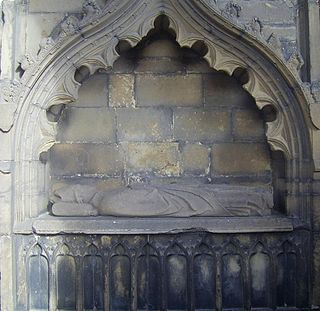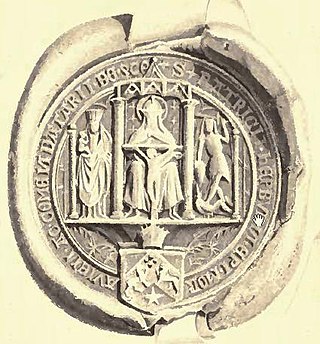Related Research Articles
The Bishop of Moray or Bishop of Elgin was the ecclesiastical head of the Diocese of Moray in northern Scotland, one of Scotland's 13 medieval bishoprics. If the foundation charter of the monastery at Scone is reliable, then the Bishopric of Moray was in existence as early as the reign of King Alexander I of Scotland (1107–1124), but was certainly in existence by 1127, when one Gregoir ("Gregorius") is mentioned as "Bishop of Moray" in a charter of king David I of Scotland. The bishopric had its seat at Elgin and Elgin Cathedral, but was severally at Birnie, Kinneddar and as late as Bishop Andreas de Moravia at Spynie, where the bishops continued to maintain a palace. The Bishopric's links with Rome ceased to exist after the Scottish Reformation, but continued, saving temporary abolition between 1638 and 1661, under the episcopal Church of Scotland until the Revolution of 1688. Episcopacy in the established church in Scotland was permanently abolished in 1689. The Bishops fortified seat for over 500 years was at Spynie Palace.
Andreas de Moravia was a 13th-century Scottish bishop. He was a younger son of Hugh de Moravia, from the family of Flemish origin who were lords of Duffus and other areas in the Greater Moray region in this period. In the time of Bishop Bricius' episcopate (1203–1222), there was a man called "Andreas" who was rector of the church of St. Peter at Duffus, and this may well have been this Andreas. He may also have been a native Scot.
Ingram Lindsay [Ingeram de Lindesay], Doctor in Canon Law, was a 15th-century Scottish cleric. Despite being of illegitimate birth - one of several sons of an unmarried nobleman and an unmarried woman - he nevertheless managed in the end to pursue a successful ecclesiastical career.

John de Winchester was a 15th-century English cleric who distinguished himself as an administrator and bishop in Scotland. Winchester was a student of canon law from 1418, graduating with a bachelorate in 1421.
William was a 12th-century prelate based in the Kingdom of Scotland. He occurs in the records for the first time as Bishop of Moray in 1152 x 24 May 1153, late in the reign of King David I of Scotland (1124–53) witnessing a grant from that monarch of the church of Clackmannan to the Abbot of Cambuskenneth. The precise date of his accession is unknown but was probably in 1152.
Richard de Lincoln was a medieval Anglo-Norman prelate. Although of English origin, he was a royal clerk in the administration of King William of Scotland. With royal support, he was elected Bishop of Moray on 1 March 1187 and was consecrated at St Andrews on 15 March by Bishop Hugh. His appointment during the rebellion of Donald MacWilliam in the north was to a dilapidated diocese. Only after MacWilliam's defeat in July could Bishop Richard begin the strengthening of his see. His episcopate marked an increase in royal patronage directed at the diocese of Moray. He witnessed many charters during his episcopate. He died in 1203, and was succeeded by Bricius de Douglas.

David de Moravia was Bishop of Moray during most of the First War of Scottish Independence. He was elected Bishop of Moray, probably in early 1299. Extended details exist regarding the election because of an extant letter of Pope Boniface VIII. The result of the election was that David had 13 votes, the Dean had 4 votes, the Chancellor had 3 votes and the Archdeacon 1 vote. The Dean declared that David was elected, and sent a request for confirmation to the Papacy. The latter found an irregularity, though what exactly this was not revealed. The election result was nominally declared void, but the Pope himself provided David directly to the bishopric. He was consecrated as bishop at Anagni in Italy on 28 June 1299, by Matthew of Aquasparta, Cardinal-Bishop of Porto.
William de Spynie was a Scottish prelate. He was a canon of Moray by 1363 and Precentor (Chanter) of Aberdeen in 1371. By 1372 x 1373, he had exchanged the latter position with William Boyl for the Precentorship of Moray. He had become Dean of Aberdeen by 1388. It is possible he had become Dean of Dunkeld in 1397, though this may be a mistake in the source, "Aberdeen" rather than "Dunkeld" being meant. At any rate, in that year he was elected as the Bishop of Moray. He travelled to France and on September 1397 was consecrated as Bishop.

Andrew Stewart was a 15th-century Scottish prelate and administrator.

Patrick Hepburn was a 16th-century Scottish prelate. He served as both pre- and post-Reformation Bishop of Moray.
Radulf or Ralph was a canon of the Bishopric of Lincoln and also identified as Master Radulf de Leicester. Following the death of Simon de Gunby, Bishop of Moray, he was elected c. 1252 as the new bishop.
Alexander Bur was a 14th-century Scottish cleric. It is highly possible that Bur came from somewhere in or around Aberdeenshire, although that is not certain and is only based on the knowledge that Aberdeenshire is where other people bearing his surname come from in this period. He entered the service of King David II of Scotland sometime after 1343, perhaps as a member of David's exiled court at Château Gaillard. Although Alexander by this point in time already held prebends in both the bishopric of Aberdeen and the bishopric of Dunkeld, on that date King David petitioned Pope Clement VI for another canonry in the bishopric of Moray. Alexander had become a royal clerk and had obtained a Licentiate in Canon Law by 1350. By the latter date, upon the death of Adam Penny, Archdeacon of Moray, Alexander himself became Archdeacon.
Walter was Chamberlain of Alan, Lord of Galloway and later Bishop of Galloway. As Alan's chamberlain, he succeeded Bishop John after the latter's death, in 1209. His election coincided with the northern expedition of King John of England to secure the submission of King William of Scotland; Alan enjoyed friendly relations with the English king, the latter wishing to make use of Alan's manpower and naval resources, and so the election of Walter may have had something to do with King John.
John of Whithorn was the medieval Bishop of Galloway. His first appearance as bishop-elect is at the coronation of Richard, Cœur de Lion as King of the English at Westminster Abbey on 3 September 1189. He was consecrated at Pipewell Abbey, Northamptonshire, on Sunday 17 September 1189.

Henry was a 13th-century Augustinian abbot and bishop, most notable for holding the positions of Abbot of Holyrood and Bishop of Galloway.

Gilbert was a 13th-century Cistercian monk, abbot and bishop. His first appearance in the sources occurs under the year 1233, for which year the Chronicle of Melrose reported that "Sir Gilbert, the abbot of Glenluce, resigned his office, in the chapter of Melrose; and there he made his profession". It is not clear why Gilbert really did resign the position of Abbot of Glenluce, head of Glenluce Abbey in Galloway, in order to become a mere brother at Melrose Abbey; nor is it clear for how long Gilbert had been abbot, though his latest known predecessor is attested last on 27 May 1222. After going to there, Gilbert became the Master of the Novices at Melrose.
Odo Ydonc was a 13th-century Premonstratensian prelate. The first recorded appearance of Odo was when he witnessed a charter by Donnchadh, Earl of Carrick, on 21 July 1225. In this document he is already Abbot of Dercongal, incidentally the first Abbot of Dercongal to appear on record.
Reinald Macer [also called Reginald] was a medieval Cistercian monk and bishop, active in the Kingdom of Scotland during the reign of William the Lion. Originally a monk of Melrose Abbey, he rose to become Bishop of Ross in 1195, and held this position until his death in 1213. He is given the nickname Macer in Roger of Howden's Chronica, a French word that meant "skinny".
Gregoir [Gregory, Gregorius] is the third known 12th century Bishop of Ross, an episcopal see then based at Rosemarkie.
Simon is the third known 12th century Bishop of Dunblane. Nothing is known of Simon's background as there are numerous Simons in Scotland in this period, both native and foreign. There is a Symon de Liberatione who witnessed a charter of King William the Lion and whom Watt and Murray suggested may have been the later Bishop of Dunblane, while there was in the same decade a local landholder and ecclesiastical patron in the diocese of Dunblane called Simón son of Mac Bethad.
References
- Dowden, John, The Bishops of Scotland, ed. J. Maitland Thomson, (Glasgow, 1912)
- Fawcett, Richard & Oram, Richard, Elgin Cathedral and the Diocese of Moray, Historic Scotland (Edinburgh, 2014), ISBN 978-1-84917-173-1
- Keith, Robert, An Historical Catalogue of the Scottish Bishops: Down to the Year 1688, (London, 1924)
- Pennant, T. "A Tour in Scotland 1769" (London, 1790)
- Watt, D.E.R., Fasti Ecclesiae Scotinanae Medii Aevi ad annum 1638, 2nd Draft, (St Andrews, 1969)